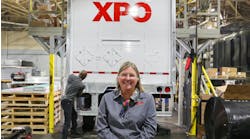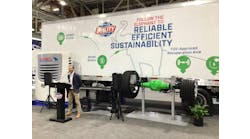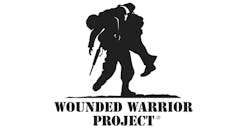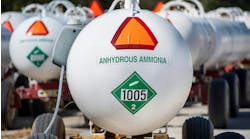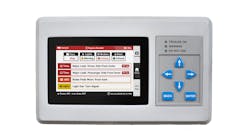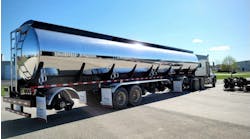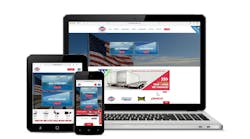By its very nature, the process of manufacturing a trailer has the potential to be hazardous to your health.
Heavy loads need to be moved. Powerful fabrication equipment generates enough force to bend, punch, and shear metal. Some operations require working off ladders or elevated platforms. Sparks can fly from grinding and welding operations, and paint booths can be home for stuff that no one wants to breathe.
A trailer plant can be a tough place to work — but it doesn't have to be. There are plenty of ways to make manufacturing a truck trailer safer and easier for the benefit of the company as well as its employees. One trailer manufacturer that seems to be doing a particularly effective job at this is Strick Corporation. The company reports a lost-time injury rate of .55, compared to the industry average of 5.1
The trailer manufacturer has been winning multiple safety awards for its dry-freight plant in Monroe, Indiana, including being named one of America's 18 safest companies earlier this year by EHS Today, an industrial health and safety magazine published by Penton Media, the parent company of Trailer/Body Builders. The company also won the Truck Trailer Manufacturers Association's Plant Safety Award in 2004 and 2005.
But it hasn't always been this way. Ten or 12 years ago, the company was averaging almost an accident a day. It was a safety record that clearly needed to change. Strick set out to do something about it.
In 2002, Strick hired a registered nurse, Cheryl Pike, to head up its health and safety program. Employees met her initial efforts with skepticism, she says, but that changed instantly in 2002 when equipment failed and an employee was crushed to death. Suddenly plant safety was seen for what it is: a matter of life and death. Everyone resolved to make the plant a safer place to work.
“When I joined Strick, the machinery used for manufacturing trailers was one of my biggest safety concerns,” Pike says. “But it was not the only one. There are other jobs in trailer manufacturing that may not have the potential for catastrophic injuries, but they can cause harm from repetitive stress.”
Pike was determined to help change the culture at Strick, both while employees are on duty and when they are away from work.
“I was a little overwhelmed at first because I also saw people who needed help maintaining a healthy lifestyle away from their job,” Pike says. “Some had gone years without ever seeing a doctor. It was more than just a workplace safety issue. When it came to health and safety issues, the plant needed a different mentality.”
“The entire mentality is different now,” says Barry Melton, manufacturing engineering manager. “A big reason is that we now encourage and empower people to get involved and make changes.”
Overcoming obstacles
The fatal accident may have removed the skepticism that employees had about a health and safety program, but Strick still had obstacles to overcome. One of the most significant was to convince employees that they are responsible for the safety of the plant and that the company is giving them the power to make things better.
“No matter how tight business has been, management has supported every safety issue that I have brought to them.”
During the past three years, Strick has invested $3.5 million at the Monroe plant in a variety of improvements designed to improve plant safety, ergonomics, and efficiency. This includes new equipment for automatically inserting rivets, improved load bars, and a $60,000 investment in equipment for tightening lug nuts. By developing equipment that successfully inserts rivets, Strick has eliminated that potential source for repetitive stress. And by automating lug nut application, the company has reduced back injuries. The fact that one person can now mount tires instead of three is an added bonus.
“We have developed and procured the equipment and made the production changes, even when the initial return on investment has been vague,” Melton says. “If we can improve the ergonomics and overall safety of trailer manufacturing, we approve it and go to work to make it a reality. We don't wait around for a comp claim.”
Communication is one of the keys to running a safe plant. To keep the communication flowing, Strick operates several committees, including a safety committee populated by employees from the various departments of the company.
Safety by committee
One of the chief roles of the committee is to investigate accidents, including a determination of whether the accident was the result of improper use of tools.
Accident reports are completed and signed by plant supervisors, Pike, Melton, and top management. Each is reviewed to attempt to identify ways to avoid similar instances in the future.
The safety committee also encourages employees to be aware of unsafe circumstances and to speak up if they see a potential hazard.
The committee also reviews accident statistics and investigates accidents topics from previous meetings to make sure ideas for improving safety do not fall through the cracks.
Strick also has other safety-related committees, including:
- Behavior-based Safety Committee
This group is responsible for watching the ways people work in order to identify unsafe practices.
- Ergonomics committee
Its charge is to identify awkward movements associated with manufacturing trailers. By doing so, proposals can be made for reducing possible repetitive-stress injuries.
- Wellness committee
Members help promote healthy lifestyles.
Keeping well
Strick encourages its employees to maintain their health. The company pays for exams and holds monthly meetings on wellness.
“We set up a calendar, with a different topic each month,” Pike says. “Sometimes we bring in outside speakers on topics such as diabetes, smoking cessation, and diet. If we can't get a speaker for a month, I will fill in.”
The wellness sessions are practiced, not just discussed at Strick. For example, the company monitors the heat index inside the plant. When it reaches 95° F, the plant takes extra breaks. At 100° F, they are sent home. The heat index never hit 100° F last summer, but the plant was closed three days in a row in 2005. Hitting 95° F and having the extra breaks, however, is not uncommon.
“The breaks are for cooling down,” Pike says. “No one is allowed to smoke during them, but they can have water or the popsicles that we provide.”
A wireless sensor measures the heat index.
“I monitor the reading,” Pike says. “But believe me, the guys in the plant do, too.”
Efforts pay dividends
In addition to the previously mentioned awards that Strick has received, the company also has been recognized by its state safety administration. The Indiana Safety and Health Recognition Program recognizes small employers that demonstrate outstanding safety and health management systems.
All Indiana businesses are eligible to participate in the statewide safety program. Successful companies such as Strick receive recognition from the State of Indiana as participants. Qualified participants are granted up to a two-year exemption from Indiana Occupational Safety and Health Administration inspections. Requirements for the program include:
-
Making a commitment to occupational safety and health.
-
Undergo a free safety and health consultation within a reasonably established timeframe.
-
Correct all hazards identified by the consultant within reasonably established timeframes.
-
Establish and maintain all of the elements of a proactive safety and health program.
Reaching out
Strick also encourages its employees to serve the community.
“We had a flood here recently, and we paid everyone to run sandbags,” Pike says. “We also pay for a day of community service. If management or hourly personnel want to spend a day helping the elderly, for example, they can do so.”
Habitat for Humanity and local blood drives are two of the company's causes.
“People get a strong sense of belonging to the company and to the community when they see how much of a difference they can make,” Pike says.
